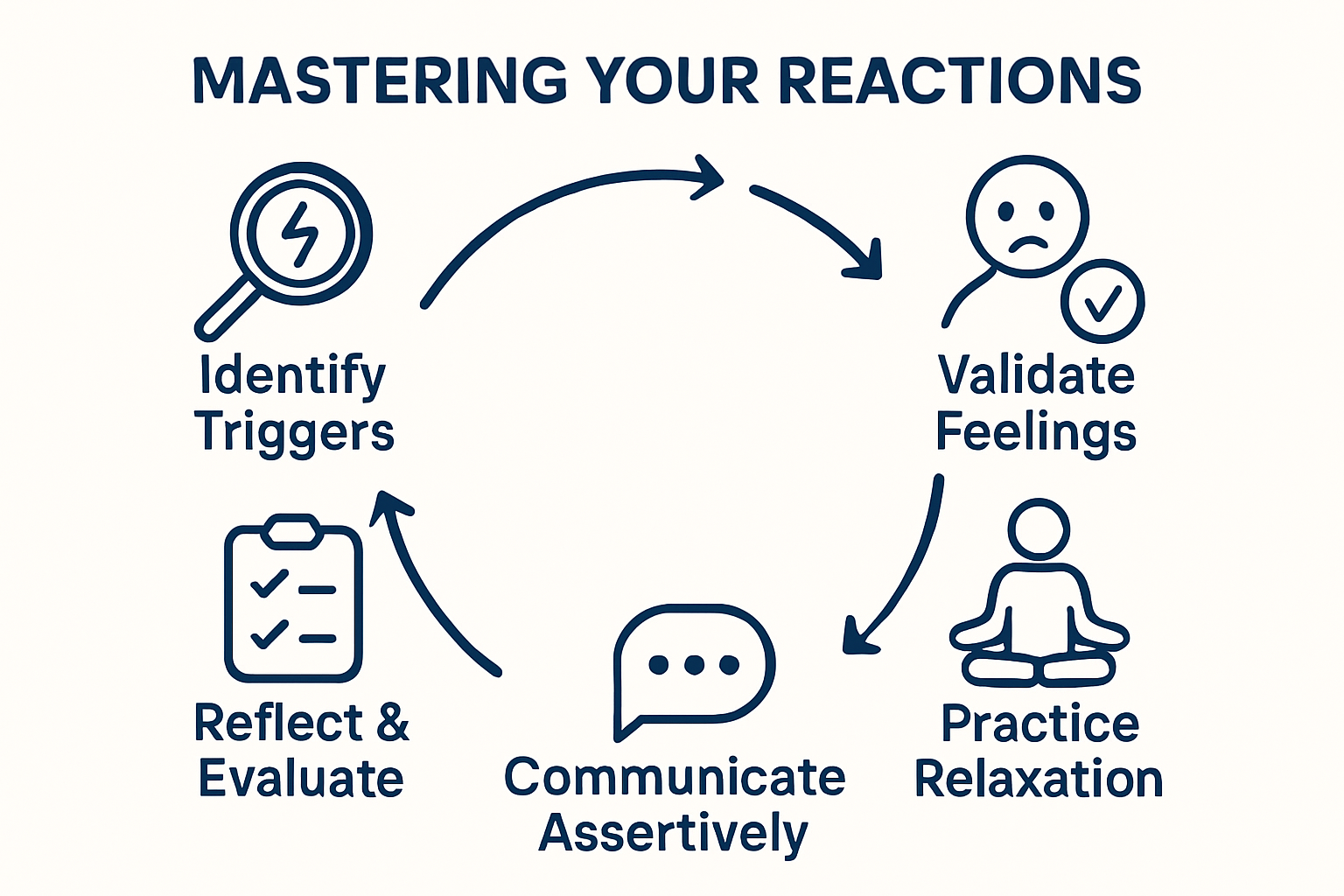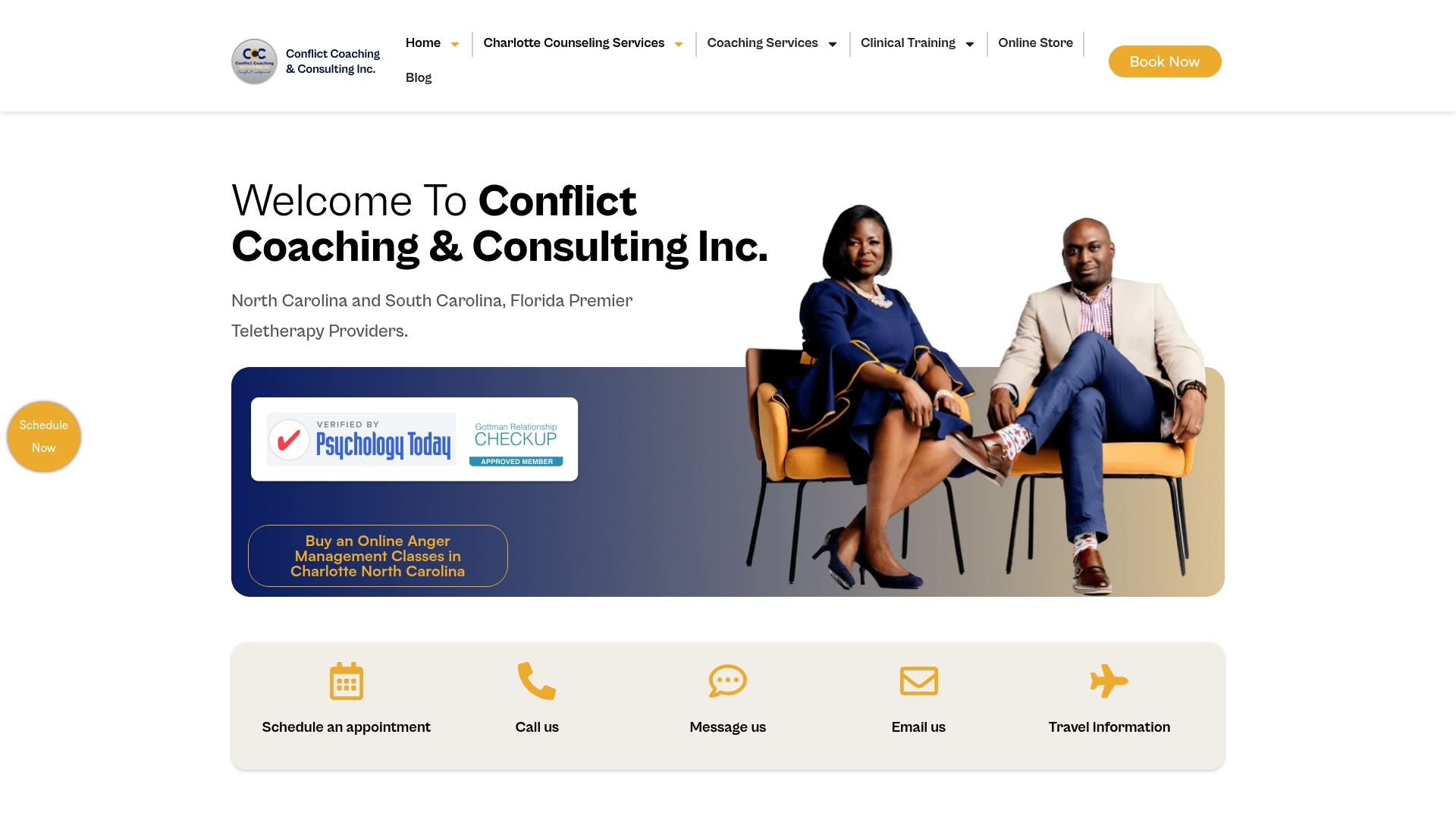Dealing with Difficult Emotions: Mastering Your Reactions

Tough emotions can seem impossible to handle when they show up at the worst times. Studies show most people are caught off guard by emotional triggers almost every day. Surprise comes next. Instead of avoiding these feelings, the real advantage comes from facing them head on and understanding what sets them off. That shift will change how you handle every tough moment from here on out.
Table of Contents
- Step 1: Identify Your Emotional Triggers
- Step 2: Acknowledge and Validate Your Feelings
- Step 3: Practice Relaxation Techniques
- Step 4: Communicate Assertively and Effectively
- Step 5: Reflect and Evaluate Your Responses
Quick Summary
| Key Point | Explanation |
|---|---|
| 1. Identify Emotional Triggers | Track situations that provoke strong emotions for greater self-awareness and understanding. |
| 2. Acknowledge and Validate Feelings | Recognize and accept your emotions as valid, fostering a compassionate internal dialogue. |
| 3. Practice Relaxation Techniques | Use deep breathing and physical methods to regain emotional balance and calm. |
| 4. Communicate Assertively | Utilize ‘I’ statements and active listening to express emotions without aggression. |
| 5. Reflect and Evaluate Responses | Regularly analyze emotional experiences to identify growth opportunities and improvement strategies. |

Step 1: Identify Your Emotional Triggers
Dealing with difficult emotions starts with understanding what sparks them in the first place. Emotional triggers are specific situations, interactions, memories, or experiences that provoke intense emotional reactions, often catching us off guard and overwhelming our ability to respond rationally. By pinpointing these triggers, you gain crucial self-awareness and the first critical tool in managing your emotional landscape.
Recognizing your emotional triggers requires honest self-reflection and careful observation. Begin by tracking your emotional responses in a dedicated journal. Whenever you experience a strong emotional reaction, pause and document the details: What happened? What specific thoughts raced through your mind? What physical sensations accompanied your emotional response? Were you feeling angry, anxious, hurt, or overwhelmed?
As you document these experiences, you’ll start noticing patterns. Some common emotional triggers include:
- Perceived criticism or rejection
- Feeling powerless or out of control
- Memories of past traumatic experiences
- Specific interpersonal dynamics that remind you of challenging relationships
- Situations that challenge your core beliefs or values
Learn more about identifying hidden emotional patterns can help you develop deeper insights into your unique emotional landscape. The key is developing a non-judgmental awareness of your reactions.
To effectively identify your triggers, practice mindful observation without self-criticism. Pay attention to the subtle shifts in your emotional state, your bodily sensations, and the thoughts that accompany intense feelings. Some people find it helpful to work with a therapist or counselor who can provide professional guidance in unpacking complex emotional responses.
Successful trigger identification means you can anticipate potential emotional challenges before they overwhelm you. When you recognize a trigger emerging, you create space to choose a measured, intentional response rather than react impulsively. This self-awareness becomes your first line of defense in managing difficult emotions, transforming potentially volatile situations into opportunities for personal growth and emotional regulation.
Step 2: Acknowledge and Validate Your Feelings
After identifying your emotional triggers, the next crucial step in dealing with difficult emotions is learning to acknowledge and validate your feelings without judgment. Validation means accepting your emotional experience as legitimate and understandable, even if the intensity of your reaction might seem disproportionate to the situation.
Emotional validation is not about agreeing with every thought or justifying destructive behaviors, but recognizing that your feelings are real and deserve compassionate attention. Start by creating a safe mental space where you can speak to yourself with kindness. Imagine how you would comfort a close friend experiencing similar emotions. Would you criticize them, or would you listen with empathy and understanding?
Practical validation techniques involve developing a supportive internal dialogue. When strong emotions arise, pause and say to yourself statements like: “It’s okay to feel this way” or “My feelings are valid, and I’m allowed to experience them fully.” These affirmations help interrupt negative self-talk and create emotional breathing room.
Some people find it helpful to use physical grounding techniques alongside emotional validation. Deep breathing, placing a hand on your heart, or sitting in a comfortable position can help you feel more connected to your emotional experience. Explore our guide on managing intense emotional responses can provide additional strategies for navigating challenging emotional landscapes.
Recognize that validation does not mean getting stuck in difficult emotions. Instead, it means acknowledging them as temporary experiences that provide valuable information about your inner world. Emotions are messengers, offering insights into your needs, boundaries, and personal experiences.
Successful emotional validation involves three key components: recognition, acceptance, and compassionate response. Recognition means clearly identifying what you’re feeling. Acceptance means allowing the emotion to exist without trying to change or suppress it. A compassionate response involves treating yourself with the same kindness you would offer a loved one experiencing similar feelings.
By mastering emotional validation, you transform your relationship with difficult emotions from one of fear and avoidance to one of curiosity and understanding. This shift is fundamental in developing emotional resilience and creating healthier, more balanced emotional responses.
Step 3: Practice Relaxation Techniques
Once you have identified your emotional triggers and validated your feelings, the next critical step is learning to regulate your emotional response through targeted relaxation techniques. These techniques serve as powerful tools to interrupt escalating emotional cycles, helping you return to a state of calm and balance.
Relaxation is not about suppressing emotions, but creating a physiological environment where you can process them more effectively. Deep breathing emerges as the most accessible and immediate technique. When intense emotions arise, focus on slow, deliberate breaths. Inhale deeply through your nose for four counts, hold for two, then exhale slowly through your mouth for six counts. This method signals your nervous system to shift from a fight-or-flight response to a more balanced state.
Progressive muscle relaxation offers another powerful approach. Starting from your toes and moving upward, systematically tense and then release each muscle group. Squeeze the muscles tightly for five seconds, then release, noticing the difference between tension and relaxation. This technique not only reduces physical stress but also provides a tangible way to experience emotional release.
Discover comprehensive relaxation strategies for emotional management can provide additional tools to expand your emotional regulation toolkit. Mindfulness meditation represents another essential technique, involving non-judgmental awareness of your present moment experience. Spend 5-10 minutes daily sitting quietly, observing your thoughts and feelings without getting caught in their narrative.
Some individuals find physical movement an effective relaxation method. Gentle yoga, walking in nature, or simple stretching can help discharge emotional energy and restore internal equilibrium. The key is choosing activities that feel natural and comfortable for you.
Environmental modifications can also support relaxation. Create a designated calm space in your home with soft lighting, comfortable seating, and potentially soothing elements like plants or calming artwork. Having a dedicated area signals to your brain that this is a safe space for emotional processing.
Below is a summary table of the main relaxation techniques mentioned in the article, including their approach and purpose. Use this table to quickly identify and select techniques suitable for managing difficult emotions.
| Technique | Approach | Main Purpose |
|---|---|---|
| Deep Breathing | Slow inhale/exhale with timed counts | Calm nervous system, reduce anxiety |
| Progressive Muscle Relaxation | Tense and release muscle groups systematically | Reduce physical & emotional tension |
| Mindfulness Meditation | Observe thoughts and feelings without judgment | Build awareness, support regulation |
| Gentle Physical Movement | Yoga, stretching, or walking in nature | Discharge emotional energy, restore calm |
| Environmental Modifications | Create calm space with lighting and soothing elements | Support relaxation, signal safety |
Verifying the effectiveness of your relaxation practice involves noticing subtle shifts. You might observe slower breathing, reduced muscle tension, clearer thinking, and a sense of emotional spaciousness. Remember that relaxation is a skill that improves with consistent practice. Be patient and compassionate with yourself as you develop these crucial emotional regulation techniques.
Step 4: Communicate Assertively and Effectively
Assertive communication transforms how you express difficult emotions, bridging the gap between passive withdrawal and aggressive outbursts. It represents a balanced approach that honors both your emotional experience and the feelings of others, creating space for genuine understanding and constructive dialogue.
Assertiveness is not about winning an argument, but creating mutual respect and clear communication. The cornerstone of assertive communication is using “I” statements that express your feelings and needs without blaming or attacking. Instead of saying “You always ignore me,” reframe the statement as “I feel frustrated when I don’t feel heard.” This subtle shift moves the conversation from accusation to personal experience.
Practical assertiveness involves maintaining calm body language that matches your verbal message. Keep eye contact steady, speak in a measured tone, and use an open posture. Your physical presence should communicate confidence and respect. When emotions run high, pause and take a deep breath before responding. This momentary break allows you to choose a measured response rather than react impulsively.
Learn strategic techniques for navigating challenging conversations can provide additional insights into effective communication strategies. Active listening plays a crucial role in assertive communication. This means fully concentrating on what the other person says, acknowledging their perspective, and responding thoughtfully rather than defensively.
Set clear boundaries as part of assertive communication. Boundaries are not walls but healthy guidelines that protect your emotional well-being. Practice saying no without guilt, using phrases like “I appreciate the invitation, but I cannot commit to that right now.” Be direct, kind, and unapologetic about your limits.

For complex emotional discussions, consider using a structured approach. Start by acknowledging the other person’s perspective, then clearly state your own feelings and needs, and finally propose a collaborative solution. This method reduces defensiveness and increases the likelihood of mutual understanding.
Successful assertive communication is measurable through specific indicators. You’ll notice reduced interpersonal tension, increased self-confidence, and a sense of being heard and respected. Your relationships will feel more authentic, with clearer expectations and fewer misunderstandings. Remember that assertiveness is a skill that improves with consistent practice and self-compassion.
Step 5: Reflect and Evaluate Your Responses
Reflection transforms emotional experiences from isolated incidents into opportunities for personal growth and understanding. This final step is about creating a compassionate learning loop where you examine your emotional responses with curiosity rather than judgment, identifying patterns and developing more effective strategies for future interactions.
Effective reflection requires honest self-examination without falling into the trap of harsh self-criticism. Begin by setting aside dedicated time each week to review your emotional experiences. This might involve journaling or creating a structured review process where you analyze specific emotional encounters. Ask yourself key questions: What triggered my emotional response? How did I manage my feelings? What worked well, and what could I improve next time?
Consider creating a simple tracking system to document your emotional experiences. This could be a digital spreadsheet or a dedicated notebook where you record emotional triggers, your initial reaction, how you managed the situation, and your reflections afterward. Look for recurring themes or patterns that emerge over time. Are there specific situations that consistently challenge your emotional regulation? Do certain people or environments tend to provoke stronger emotional responses?
Here is a handy checklist to help you reflect and evaluate your emotional responses, as described in Step 5. Use this table to guide your review process each week and track your progress over time.
| Reflection Step | What to Check For | Notes/Status |
|---|---|---|
| Identify Triggers | Document what set off the emotion | |
| Record Initial Reaction | Note physical sensations & thoughts | |
| Management Technique Used | Which coping method did you apply? | |
| Outcome Assessment | Did the strategy help? | |
| Pattern Recognition | Notice recurring themes or situations | |
| Align Actions with Values | Did you act according to your values? | |
| Plan for Improvement | What could you try differently next time? |
Explore our comprehensive guide to emotional self-assessment can provide additional tools for deeper emotional insight. The goal of reflection is not to achieve perfection but to develop greater self-understanding and emotional resilience.
Practical reflection involves breaking down your emotional responses into observable components. Examine your physical reactions, thought patterns, and behavioral choices. Were your actions aligned with your values? Did you communicate effectively? What alternative approaches might have been more productive?
Develop a compassionate inner dialogue during this reflection process. Instead of saying “I handled that terribly,” reframe your thoughts to “I’m learning and growing. This experience provides valuable information for my personal development.” This approach transforms reflection from a potentially painful process into an opportunity for growth and self-improvement.
Successful reflection is measurable through tangible changes in your emotional responses. You’ll notice increased self-awareness, more measured reactions to challenging situations, and a greater sense of emotional control. The ultimate verification is your ability to approach future emotional challenges with more wisdom, patience, and understanding than before. Remember that emotional mastery is a journey, not a destination, and each reflection brings you one step closer to more balanced and fulfilling interactions.
Move Beyond Emotional Triggers and Master Your Reactions
Are you tired of feeling overwhelmed by emotional triggers or stuck in patterns you can’t seem to break? If you’ve connected with the strategies in our article, now is the time to bring expert guidance into your journey. Our team at Mastering Conflict offers evidence-based services designed to help you not only identify emotional triggers but also transform your emotional responses in real time.

Work with licensed professionals who understand the impact of unmet emotional needs, recurring conflict, and the struggle for self-control. Whether you need anger management classes, couples therapy for building better communication, or individual counseling for emotional resilience, our online and in-person services are here for you. Don’t let another day pass before taking action. Visit Mastering Conflict to schedule your consultation and start building better emotional habits today.
Frequently Asked Questions
What are emotional triggers?
Emotional triggers are specific situations, interactions, memories, or experiences that provoke intense emotional reactions, making it essential to recognize them for effective emotional management.
How can I validate my difficult emotions?
To validate your emotions, create a safe mental space to accept your feelings without judgment. Use compassionate self-talk, such as affirming that it’s okay to feel what you’re feeling.
What relaxation techniques can help regulate emotions?
Effective relaxation techniques include deep breathing, progressive muscle relaxation, mindfulness meditation, and gentle physical movement like yoga or stretching. These help create a calm environment to process emotions better.
How can I communicate my feelings effectively?
Use assertive communication by expressing your feelings with “I” statements and maintaining calm body language. Acknowledge the other person’s perspective and establish clear boundaries, which encourages mutual respect in conversations.
Recommended
- Anger Management Exercises And Relaxation Techniques
- Anger Management Tips That Actually Work (2025)
- Anger Warning Signs: How to Recognize and Respond Early – Mastering Conflict
- Wrath vs Anger: Clear Differences You Need to Know
- Psychology of Forex Trading: Mindset for Consistent Profits 2025
- How to Be a Better Husband: Build Emotional Connection

4 Responses